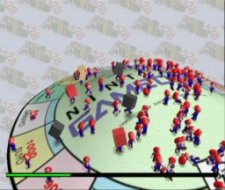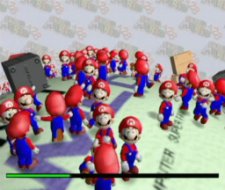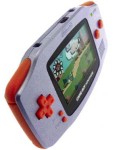When Nintendo wants to show off their exciting new hardware, it's no surprise when mascot Mario and friends play a role in the technical demos.
Balloon Trip
System: Nintendo DS
Date: 5/11/2004 (E3)
Shown during E3 2004, this became Yoshi's Touch & Go, confirmed as a full game by Nintendo on October 7th, 2004.
Game Boy Color
Date: 1998
A demo cartridge seen in stores to show off the Game Boy Color. The continuously looping movie shows short gameplay clips of Tetris DX, Wario Land II, and The Legend of Zelda: Link's Awakening, mixed in with fancy graphic effects and stark white-on-black fact screens (such as "Color LCD Screen") printed in plain text.
The three Wario Land II clips show off the color version of the WL2 originally released for the original Game Boy. One of the graphic demos is a still image of Wario giving us the thumbs-up. Another is a colored Mario sprite from Super Mario Land 2 running back and forth under a rising and falling "Game Boy" sign and a "Color" logo with moving letters. The second time we see Mario, he turns on the switch which makes the screen flash a bunch of colors. Then, Mario leaves and Wario enters. Wario pulls the cord, the sign falls and flattens him, the color reverts to greyscale, and Wario waddles off the screen.
Screen shots
- "Nintendo Game Boy now in Color"
- Wario art
- Wario Land II (color version) title screen
- WL2 clip #1
- WL2 clip #2
- Mario runs around
- WL2 clip #3
- Mario turns on the color
- Color!
- The demo had no seizure warning.
- Wario investigates
- Squish.
Luigi's Mansion
System: GameCube
Date: 8/24/2000 (Nintendo Space World, Japan)
Mario 128
System: GameCube
Date: 8/24/2000
GameCube demos were shown for the first time at Nintendo's Space World 2000 expo. Shigeru Miyamoto showed the Mario 128 video on a big screen as he talked about the demo and the GameCube. The following is a quote from Nintendo's website.
With the help of one of his staff members, Mr. Futoda, Mr. Miyamoto ran through a very humorous demonstration of the capabilities of the Nintendo GAMECUBE. Within short order he had displayed 128 Marios on the screen, each made up of about 700 polygons (the same model was used in Super Mario 64) running at 60 frames per second. Each Mario ran around on a circular platform, interacting with other Marios and 128 cubes strewn about on the landscape. Throughout the demonstration a green bar at the bottom of the screen monitored the processing time. If that green bar reached all the way to the right side of the screen, the demo would be running at 30 frames per second, the same rate as Super Mario 64. During the entire demo, including the later parts where Mr. Miyamoto warped the flat platform to complicate the demo's real-time physics and collision detection, and applied many special effects to the polygons, the green bar didn't even go halfway across the screen.


So what happened to Mario 128? At the 2007 Game Developers Conference, Miyamoto explained, through translator Bill Trinen:
Now, the purpose of that demo was to show how new technology of the GameCube could dynamically change the nature of Mario games. So, when people ask me what happened to Mario 128, I'm always at a loss as to how to answer. Because, actually, most of you have already played it, but you played it in a game called Pikmin. See, this game featured one element of Mario 128, that allowed a large number of characters to operate independently and as a group, with some advanced AI. But, of course, if I were to tell you all that this is what happened to Mario 128, I think you'd all be pretty angry. So of course you'll be experiencing ... another element of Mario 128 fairly soon. In Super Mario Galaxy, you'll be playing on numerous spherical stages, and this was one of the experiments that we were conducting at the time of Mario 128.
Mario Kart GC
System: GameCube
Date: 8/24/2000 (Nintendo Space World, Japan)
A seven-second clip of Mario and Luigi driving karts on top of a giant GameCube, much like the Battle Mode stage in Mario Kart: Double Dash!!.
Mario's Face
System: Nintendo DS
Date: 5/11/2004 (E3)
More info soon.
Game Cube World
Date: December 2001
More info soon.
Virtual Boy
More info soon.
Yoshi Demo
System: Game Boy Advance
Date: 1999

|
| Nintendo released this promotional shot of a GBA running Yoshi Demo. |
This demo starts off with a rotating 3-D Yoshi island, then drops Yoshi into a short level based on Nintendo 64's Yoshi's Story. The screen can scroll in all directions, but there is no end because the level loops around. Yoshi's moves are limited; he can walk, jump, flutter jump, and ground-pound. The Select button takes three petals off of Yoshi's health meter (or kills him if he has no petals), and the L button makes Yoshi act excited like he just sniffed out a hidden fruit in the N64 title. Though Yoshi starts with three eggs, there is no way to throw them, nor can he eat enemies to make more. Instead, Yoshi loses an egg when he takes damage, and the only way to get more is to hit a "Message Block", then ground-pound the purple "? Balloon" that appears. Eggs will restore three petals when collected. If Yoshi falls down a pit, he will jump back out (costing him three petals) unless he has zero petals, in which case he will die.
Nintendo supplied "Yoshi Demo" with each GBA development kit as they started to dole them out shortly after it was first shown in April 2000. In December 2001, IGN posted pictures of a dev kit running the demo, which they claimed were taken in August 1999. IGN also said that Yoshi could eat enemies and make eggs, but there is no evidence in their screen shots.
Screen shots








